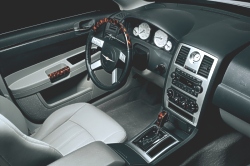
.
. .
..
. . . .
Chrysler Cars Dodge 2004 DaimlerChrysler 2003 Concepts: DaimlerChrysler 2002 Concepts: DaimlerChrysler 2001 Concepts:
© 1999-2004
Copyright |
DaimlerChrysler: Chrysler 300C
Chrysler 300 Displays Dramatic New Design Direction With an entirely new shape based on the company’s all-new rear-drive architecture, the new 2005 Chrysler 300 features classic proportions. Technologies such as Electronic Stability Program (ESP), All-speed Traction Control and anti-lock brake systems (ABS) have reached new levels of advancement to control rear-wheel-drive cars in ways that are transparent to the driver. ABS keeps the vehicle straight, while retaining steering capability when braking on slippery surfaces by preventing wheel lock-up. All-speed Traction Control enhances mobility and prevents wheel slip when accelerating on slippery surfaces. It also provides a measure of directional stability control—an advancement beyond prior traction control systems. ESP enhances driver control and helps maintain directional stability in turns, including uneven surface conditions and patchy snow, ice or gravel. If there’s a discernible difference between what the driver indicates through the steering and the vehicle’s path, ESP applies selective braking and throttle control to put the car back onto the driver’s intended path. The system is calibrated for better control of the vehicle under a variety of conditions and operates in a manner that is not intrusive under normal driving. Diverse Powertrain Options Create Distinctly Different Models A car designed from the ground up with performance and luxury in mind, demanded powertrain systems that exceeded customers’ expectations. Chrysler engineers developed three engines and two transmissions to provide optimum powertrain choices for Chrysler 300. 2.7-Liter, DOHC V-6 Engine The 2.7-liter, DOHC V-6 engine provides the Chrysler 300 with an outstanding combination of performance, fuel economy, quietness and durability. The engine produces more low-speed torque at launch and during mid-range operation for strong performance in everyday driving. The 2.7-liter engine has been mated to a revised version of a proven Chrysler Group four-speed automatic transmission. The 42RLE four-speed automatic transmission is a variant of the 42LE automatic transmission used on previous Chrysler Group vehicles. 3.5-Liter, SOHC V-6 Engine The Chrysler 300 Touring and 300 Limited models feature a 3.5-liter, SOHC V-6 engine with high-output performance, matched with the revised 42RLE four-speed automatic transmission on RWD applications. This engine provides the perfect blend of performance and economy. 5.7-Liter, HEMI® V-8 Engine For the ultimate in performance, the Chrysler 300C is equipped with a standard 5.7-liter, HEMI V-8 engine. This engine offers more power and torque than any Chrysler passenger car engine since the legendary 426 HEMI of the ’60s and ’70s. Today’s engine produces 340 horsepower (254 kW) at 5,000 rpm and 390 lb.-ft. (525 N•m) of torque at 4,000 rpm. The 5.7-liter HEMI is mated with the proven DaimlerChrysler five-speed automatic transmission, offered for the first time ever in a Chrysler Group passenger car. The five-speed automatic transmission features the AutoStick® driver-selectable range control, which offers a fully automatic or manual shifting selection. Industry-First Multiple Displacement System (MDS) is Standard on Chrysler 300C The 2005 Chrysler 300C is the first modern volume production vehicle in North America to feature cylinder deactivation. MDS seamlessly turns off the fuel consumption in four cylinders of the 5.7-liter HEMI engine when V-8 power is not needed, improving fuel economy up to 20 percent. Optional All-wheel Drive System Provides Best in Passenger Car Four-Season Traction All-wheel drive is available on Chrysler 300 Touring and 300 Limited models equipped with a 3.5-liter High-Output V-6 engine, as well as the 5.7-liter HEMI-powered Chrysler 300C. By driving continuously through all four wheels, the all-wheel-drive system provides excellent cornering balance under all driving conditions, and better traction in snow and wet-weather conditions. Combined with standard All-speed Traction Control and ESP, the all-wheel drive system adds outstanding performance and stability under all traction conditions. Chrysler Group’s five-speed transmission with AutoStick, 18-inch polished aluminum wheels, performance disk brakes and a 19.0 gallon fuel tank are included on all-wheel-drive models. Chrysler Development System (CDS) Improves Quality and Speed-to-Market The Chrysler 300 is the first high-volume vehicle completely designed and engineered under the Chrysler Development System. The comprehensive, coordinated, product creation process improves quality and speed-to-market, while reducing costs and encouraging innovation in new products. CDS emphasizes systems engineering and up-front planning and design to avoid time-consuming and costly changes during the later phases of the product development cycle. With CDS, all product and process planning is completed and fully integrated before production tooling begins. These improvements in quality are demonstrated in the seven-year/70,000-mile limited powertrain warranty on the Chrysler 300 and other Chrysler Group products. Engineers Analyze in World-class Scientific and Testing Laboratories The Chrysler 300 also was one of the first vehicles to benefit from the new $36 million Aero-Acoustic Wind Tunnel at Chrysler Technology Center (CTC), Auburn Hills, Mich. With this latest addition to the world-class scientific and testing laboratories at CTC, engineers tested full-size clay models enabling early analysis of many different designs to determine the best aerodynamic results. The wind tunnel helped engineers reduce internal and external wind noise. As a result of this testing, several design and engineering changes were implemented to reduce wind noise, vehicle noise, vibration and harshness and improve weather protection. During the development process of the Chrysler 300, a continuous exchange of engineering best practices between all DaimlerChrysler partners resulted in higher standards for passenger safety, security and comfort. Significant advancements in the technology inherent with rear-wheel drive created an opportunity to engineer Chrysler 300 with a longer wheelbase for a smoother and more balanced ride. The wider track also provides better stability, handling and traction control on various surfaces and weather conditions. Leading computer technology also was used to anticipate how the components of the Chrysler 300 would work together during a crash to absorb and reduce crash forces sent to passengers. Pictures: Chrysler
|
.
|






















